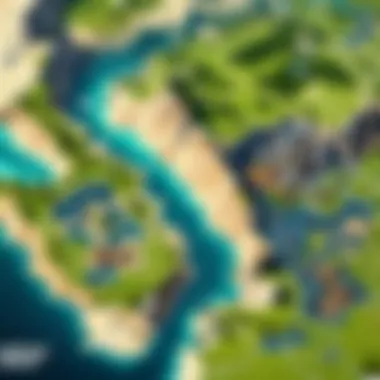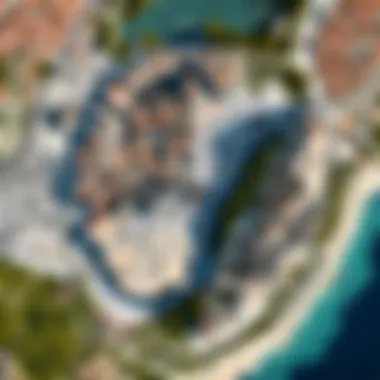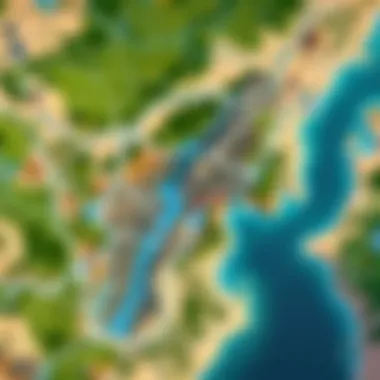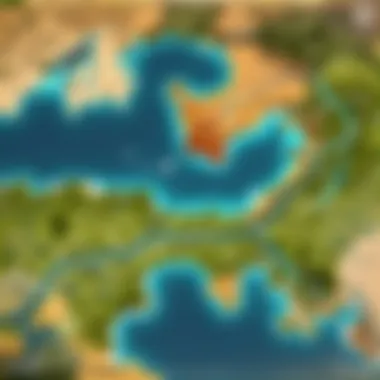The Evolution of Maps in Valorant: An In-Depth Analysis


Game Overview
Foreword to Valorant
Valorant is a tactical first-person shooter developed by Riot Games. Launched in June 2020, it quickly captured the attention of gamers for its precise gunplay and strategic depth. Unlike some competitors, Valorant emphasizes teamwork alongside individual skill. Set in a near-futuristic world, players control characters known as Agents, each with unique abilities that differentiate them in gameplay.
Game mechanics and objectives
The fundamental mechanics of Valorant revolve around team-based, objective-driven gameplay. Matches generally consist of two teams of five players each, switching between attacking and defending sides. The primary goal, for attackers, usually focuses on planting the bomb called the Spike, while the defenders must prevent this from happening. Failure of any team results in a loss in a round. Teams win a match when they secure a set number of round victories, confirming the importance of strategy and tactics that we will discuss in detail later.
Brief history of the game
Valorant's historical rollout started with a closed beta in April 2020. During this time, Riot Games gathered feedback from numerous players to refine its mechanics and maps. Post-release, influences from prior shooter games like Counter-Strike and Overwatch became apparent but wrapped in Valorant’s unique aesthetic and approach.
Subsection: List of playable agents and their unique abilities
Valorant offers a diverse roster of Agents, which players can choose from. Each agent has special abilities that morph tactical playstyles, making map navigation crucial. Here are some notable Agents:
- Jett: A duelist known for her agility and evasiveness.
- Sova: An initiator who specializes in scouting techniques.
- Sage: The team’s healer, crucial for sustained engagements.
- Cypher: A sentinel adept in gathering information and locking down areas.
Player Community
The Valorant player community thrives on collaboration and creativity. A variety of platforms, including forums on Reddit and social media pages, allow discussions on tactics, updates, and strategy guides which invite all players from novices to veterans.
Insight arises best through shared knowledge within this evolving gaming community.
This dynamic enhances the game experience and fosters an environment rich in strategy and personal expression. As we segue into the next sections, further exploration of maps will illustrate their significance in shaping both individual and team play. The analysis of these environments offers insight into how integral they are to advancing cohesive strategies.
Prelude to Maps in Valorant
Maps in Valorant are fundamental to the game's tactical depth. They provide much more than just a battlefield; they shape player interactions, strategies, and how teams function during matches. Understanding this aspect is crucial, especially for players looking to refine their gameplay or those engaged in competitive scenarios.
The Importance of Maps in Tactical Shooters
In tactical shooters, maps are the stage where every action unfolds. Each map is designed with unique features that influence tactics and strategies. Some key importance includes the following:
- Strategic Variety: Maps offer different layouts, forcing teams to adapt their strategies. Based on terrain, barriers, and choke points, teams must communicate and adjust choreography in their movements.
- Positioning and Advantage: The way a map is structured can grant advantages regarding control points. High ground, for example, can be integral to securing objectives or avoiding ambushes.
- Equipment Use: Each map’s design frequently encourages creative use of kayos, stealth elements, and abilities unique to each agent in Valorant, adding another layer to gameplay.
In essence, maps act as the game’s backbone, defining how teams engage with one another throughout matches.
Overview of Valorant’s Map Design
Valorant’s map design is a triumph of strategic construction balanced with aesthetic considerations. The developers have systematically curated map hubs that promote engagement and competition.


Maps in the game usually present the following duality:
- Linear vs. Non-Linear: Many maps feature a linear design that channels players towards focused objectives. However, others present more open, non-linear pathways, giving teams choices in navigation and strategy.
- Verticality and Canopy: Ingeniously, vertical elements often promote height advantage. Maps with multi-level terrains add layers to encounters and require players to think vertically.
These design principles enhance gameplay further, pushing teams toward collaborative strategies that factors in tested communication and adaptability.
“In Valorant, the combination of teamwork and map knowledge stands as the core tenet of a successful strategy.”
Each map's particularities demand unique approaches for completing objectives, forcing consistent learning and improvement from every player.
Key Maps in Valorant
Maps in Valorant are not merely backgrounds for battles; they are complex ecosystems that inform every tactical decision. Each map offers unique layouts, weapon placements, and interaction points. As players become immersed in the game, the significance of these maps becomes evident. Key maps are crucial because they serve as a canvas for player strategies. Understanding the mechanics and design principles behind them enhances gameplay and performance.
Bind: Mechanics and Layout
Bind is known for its teleporters, offering quick transitions between sites. The mechanics supported here are intricate, promoting a swift pace of play. Players often engage in innovative flanking maneuvers because they can use teleporters to reposition unpredictably. The layout provides dual pathways that encourage players to use communication effectively during matches, be it offensive pushes or defensive holds.
Haven: The Unique Three-Site Structure
Haven stands apart due to its three-bombsite format. This design creates a distinct dynamic, forcing players to continuously adjust and adapt their strategies. The added complexity requires effective teamwork and communication. Every round turns into a strategic underpinning, whereby attackers must decide which site to commit to, while defenders. must spread resources efficiently to counter potentially increasing threats at any bombsite.
Split: Verticality and Flow
In Split, verticality is a critical feature. Players utilize ropes and ledges to create multipoint engagements in fights. This vertical aspect elevates gameplay unpredictability. The map is often characterized by a balance of choke points and wide-open areas, making sightlines essential in coordinate strategies. Proper use of space promotes map control, often determining the flow of the game.
Ascent: Importance of Mid Control
Ascent places significant emphasis on central control of the map. The mid-section serves as a vital corridor of warfare; controlling this area enables advanced tactics. Whether players aim to pull off fast-paced rotations or slowly suffocate their opponents, mid control fuels thoughts around map domination. Such concepts make Ascent pivotal to learning focused player dynamics.
Icebox: The Dynamic Environment
Icebox introduces unique environmental challenges, such as vertical sites and hard-to-reach spots. Tactical advantages often vary dramatically depending on player mastery of the specific áreas within. Whether taking sniping positions or rushed exercises for quick point control, Icebox's adaptability prompts continuous strategizing amongst teams.
Breeze: Expansive Layout and Strategies
With Breeze, the expansive layout promotes long-range duels. This layout compels players to employ spotting and precise firing as ways to gain openings within enemy forces. Strategic placement makes cover and area knowledge essential. Learning how to traverse vast expanses defines gameplay, making teamwork essential in execution of plan versus opposing strategies.
Fracture: Dual Spawn Points and Strategic Considerations
Fracture introduces dual spawn points, diverging from typical layouts and crafting new tactical opportunities. Players must navigate carefully through asymmetric design focusing on map topography. Strategic considerations greatly hinge upon the orientation between attackers and defenders, fostering fresh strategies. Victory hinges on soldier foresight and effective communication given the unique flow brought about by multiple spawns.
The design of VALORANT's key maps requires gamers to think critically and adaptively. Comprehending every unique layout can change the outcome of matches.
With each map examined, one can see that their layouts drive the pacing of battles, starkly influencing how players respond during matches.


Map Rotation and Its Impact on Competitive Play
In the competitive environment of Valorant, constant map rotation holds significant importance. It keeps the gameplay fresh and forces players to adapt their strategies. Moreover, these rotations help in preventing the game from becoming stale. A variety of maps provides teams opportunities to showcase their skills and create diverse strategies that are crucial in high-level play.
The dynamic nature of map rotations invites discussion on several elements. First, it requires teams to continuously practice and develop not only individual map strategies but also adaptable team tactics. Understanding the maps means players can predict opponent movements, capitalize on positioning, and exploit geographical advantages.
Another key benefit revolves around balancing the competitive environment. A diverse map pool helps reduce the risk of dominant strategies overshadowing different playstyles. When the same maps remain too long, specific tactical setups can become routine, leading to predictability. Frequent map changes【source】【source】 initiate an ongoing evolution in gameplay.
While rotation benefits the game, teams must also consider the drawbacks. New maps requireadditional time investiagation. If certain maps are overly complex or uniquely challenging, they might alienate casual players. Thus, developers introduce maps like Fracture or Breeze cautiously, evaluating player feedback to maintain balance. Ultimately, continual refinements in map rotation leverage both player skill and strategic depth. Balance, creativity, and relevance tie together, enhancing the overall competitive experience.
Understanding Competitive Map Pools
Competitive map pools are intricate in their setup and selection. Each map serves unique roles in the strategy and character selection process. Teams often select maps based on their strengths and the weaknesses of the opposition. For competitive play, a clear formula exists for establishing a balanced and varied map pool.
A common practice is for competitive leagues to present a set group of maps each season. Objectives often include:
- Ensuring diversity across different playstyles.
- Decreasing stale maps and tactical counters.
- Allowing players and teams to make real adjustments as the meta evolves.
Incorporating community feedback allows developers to shift the map displacement. Listening to gameplay experiences ensures that existing maps are neither abandoned floors nor protocols without vitality. Roles of maps expand as gameplays elevate thematic competition.
Effects of Map Changes on Player Strategies
Every change to a map does more than adjust visuals. Design adjustments can substantially influence game strategies. For example, the introduction of new pathways, sightlines, or bomb sites forces players to rethink common tactics, although gameplay fluidity remains essential.
New maps tend to heighten creativity while unraveling existing player-balanced strategies. Individuals may feel something consistent changes post-patch scenario since spontaneous tactical updates can spur unanticipated challenges. It quickly leads individuals to test previously untrialed sum-ups or coordination mechanics.:m. Accordingly, teams must engage collaboratively to remain ahead of the game.
An additional factor is how existing players must shift from residual strategies on older maps. Defensive positions and indications can adjust drastically. New tech-based tools arise as gamers create their routines around enhancing player-floor interactions. Ultimately, strategical shifts amplify excitement for engaged communities because immersion transforms styles, and challenge persists through innovation. This is vital for firmly transforming players deeply rooted in their previously played map regimes!
Player Adaptation to Map Changes
Player adaptation to map changes in Valorant is crucial for maintaining competitive viability. It involves continuously evaluating strategies and adjusting gameplay based on map dynamics. This adaptability can greatly influence how players approach each match and engage with opponents.
Changes to maps can vary, from minor adjustments to major redesigns. Players must react to these changes efficiently, which is challenging, especially in a tactical shooter emphasizing precision and strategy. Each map features unique terrain and layout beneficial to different agent abilities.
Understanding these elements allows players to devise effective early game strategies. Players who neglect adaptation can find themselves lagging behind their competition, as an ineffective strategy may limit team performance.
Early Game Strategies: Understanding Terrain
The early game sets the tone for the rest of the match in Valorant. Players need to grasp the specific characteristics of the terrain for optimizing positioning, coordination, and movement. Terrain understanding contributes significantly to map control and whether a team can seize advantageous positions.
Factors such as sightlines, cover, and choke points play pivotal roles in determining engagements. Early decisions can lead to crucial information gathering, allowing teams to anticipate opponent movements and respond effectively.
In early rounds, players should assess:


- The layout of key chokepoints and essential pathways.
- The positioning of traps or barricades that may hinder opponent mobility.
- Opportunities to leverage high-ground areas for optimal vantage points.
Employing these insights can maximize team efficiency. Additionally, sound cues from the environment provide persuasion for players to enact strategies around their insights even further.
Mid to Late Game Adjustments
As the match progresses, map knowledge must evolve. Adaptation becomes increasingly important in the mid to late game due to the heightened stakes. Teams that initially began strong on the map might face difficulties adjusting to their opponent’s responses. This is especially apparent as ultimates are utilized and utility usage ramps up.
Teams should always revise strategies by paying attention to:
- Shift in Map Control: Maps may not play equally throughout a match. Early shifts in power constrained to particular sites can influence plays on others, meaning players must assess which areas are strongest for engagement.
- Enemy Tendencies: Players should note how opponents adjust. Some objectives may allow for repeated strategy rather than immediate deviation. Being aware of this provides intelligence that can guide countermeasures.
- Resource Management: Adequate utilization of abilities and ultimates alters how conflict unfolds. Late-stage insights into opponent strategies can outline resource distribution, fulfilling or exceeding planned responses.
Adjustments in the mid and late game require constant evaluation. Playing adaptively can turn abrupt deficits into recoverable wins through precise map insight and confrontational intel. Ultimately, success in Valorant vastly revolves around player adaptability regarding map awareness and specific interactions that follow.
Current Trends in Map Design
Map design in Valorant has continously evolved. The developers prioritize various factors, including player engagement and competitive balance. A nuanced understanding of current trends reveals how maps can influence the overall gaming experiance.
Incorporation of Player Feedback
Developers at Riot Games have shown a clear commitment to integrating player feedback into the design process. They understand that maps play critical roles in gameplay dynamics. Players often express preferences and concerns through platforms like Reddit and forums. This feedback loop is not just periodic; it is a continuous dialogue. The adjustments made in maps like Breeze came directly from community insights. By engaging with players, developers can identify crucial areas needing improvements.
Additionally, the process allows players to feel a sense of ownership over the maps. When players see their suggestions reflected in continuous updates, it fosters loyalty and drives player engagement. Those who feel their voice matters often extend their playtime. At times, players’ interactions also influence the thematic evolution of maps. Maps become more than tactical battlegrounds. They evolve into engaging environments, largely shaped by collective community input.
Technological Advancements in Map Creation
Recent advancements in technology have also had a significant impact on map design. Tools and software used for developing maps have nowadays become more powerful. This permits for greater precision and creativity. For example, the use of advanced 3D modeling programs enhances texture quality and environment realism. New trajectory and line-of-sight analysis tools also help developers make better strategic choices while designing.
Moreover, data analytics play an essential role in shaping maps. Gathering gameplay data allows developers to observe player behavior in real-time. Different strategies can emerge over time; understanding these can lead to significant innovations. Controls for player movement and dynamics shape balance decisions. Map designs adjust to compete with threatening gameplay strategies successfully.
“The combination of player feedback and technological advancements apace premier maps’ development, propelling the narrative shaping of new environments.”
Additionally, with improvements in rendering technology, players experience crisper visuals. Realism and detail in the design create mo immersive experiences. Maintaing key structural and strategic elements together ensures a balance that sustain competitive play.
Overall, emphasizing player feedback and leveraging technology in map design reflect current trends in Valorant. As the game matures, both factors are pivotal in retaining interest and mitigating competitive stagnation.
Closure: The Future of Maps in Valorant
The importance of this conclusion lies in how it encapsulates the thematic evolution of maps within the game, while also looking forward. Understanding the future of maps in Valorant is not just about what maps may come next. It’s about acknowledging how player feedback, changing competitive dynamics, and technological advancements will shape experiences. By anticipating potential updates and innovations, players and developers alike can strive to enhance strategic depth and player engagement.
Potential Updates and Community Engagement
Feedback from the community has proven vital in shaping the future direction of Valorant maps. Recognizing patterns in player experience can lead to actionable updates. For example, zones on maps that players consistently struggle with might receive adjustments for clarity and tactics. Moreover, developers might introduce new elements or change aesthetics to revitalize some maps, making gameplay feel fresh.
Community engagement is another crucial aspect. Consistent communication between developers and players fosters an atmosphere where suggestions and critiques can lead to tangible improvements. Participating in community forums, such as Reddit discussions, can allow players to voice their opinions on map designs and gather insights from one another. Recognition from developers of this feedback loops back to how the developers rethink and redefine existing maps.
Final Thoughts on Strategic Map Play
Looking ahead, the strategies influenced by updated maps will undoubtedly affect player dynamics in competitive play. Every time a weapon or map detail changes, it results in a ripple effect on tactics. Consider players experimenting with new paths or revisiting perceptions on older terrains after adjustments.
A strong understanding of evolving map strategies will set players apart in both casual and competitive environments. Thus, being observant of ongoing changes—even minor tweaks—will allow players to maintain their competitive edge.



